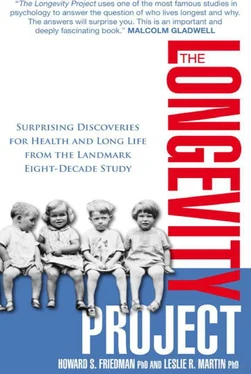For more about our core study on the Terman veterans, see G. H. Elder, E. C. Clipp, J. S. Brown, L. R. Martin, and H. S. Friedman, “The Life-Long Mortality Risks of World War II Experiences,” Research on Aging 31 (2009): 391-412.
For discussions of the disease-prone personality, see H. S. Friedman and S. Booth-Kewley, “The ‘Disease-Prone Personality’: A Meta-Analytic View of the Construct,” American Psychologist 42 (1987): 539-55; H. S. Friedman, “Personality, Disease, and Self-Healing,” in Foundations of Health Psychology , ed. H. S. Friedman and R. C. Silver, 172-99 (New York: Oxford University Press, 2007); and H. S. Friedman, “The Multiple Linkages of Personality and Disease,” Brain, Behavior, and Immunity 22 (2008): 668-75.
The large national study of depression in heart attack patients can be found at L. F. Berkman, J. Blumenthal, M. Burg, R. M. Carney, D. Catellier, M. J. Cowan, S. M. Czajkowski, R. DeBusk, J. Hosking, A. Jaffe, P. G. Kaufmann, P. Mitchell, J. Norman, L. H. Powell, J. M. Raczynski, and N. Schneiderman, “The Enhancing Recovery in Coronary Heart Disease Patients (ENRICHD) Study: The Effects of Treating Depression and Low Social Support on Clinical Events after Myocardial Infarction,” Journal of the American Medical Association 289 (2003): 3106-16.
For more information on our study of mental health and mortality risk, see L. R. Martin, H. S. Friedman, J. S. Tucker, J. E. Schwartz, M. H. Criqui, D. L. Wingard, and C. Tomlinson-Keasey, “An Archival Prospective Study of Mental Health and Longevity,” Health Psychology 14 (1995): 381-87.
More on the genetic study of depression is in A. Caspi, K. Sugden, T. E. Moffitt, A. Taylor, I. W. Craig, H. Harrington, J. McClay, J. Mill, J. Martin, A. Braithwaite, and R. Poulton, “Influences of Life Stress on Depression: Moderation by a Polymorphism in the 5-HTT Gene,” Science 301, no. 5631 (2003): 386-89.
To read more about one of Vaillant’s studies of the effects of World War II experiences, see K. A. Lee, G. E. Vaillant, W. C. Torrey, and G. H. Elder, “A 50-Year Prospective Study of the Psychological Sequelae of World War II Combat,” American Journal of Psychiatry 152 (1995): 516-22.
For the study of Vietnam veterans, see A. C. Phillips, G. D. Batty, C. R. Gale, I. J. Deary, D. Osborn, K. MacIntyre, and D. Carroll, “Generalized Anxiety Disorder, Major Depressive Disorder, and Their Comorbidity as Predictors of All-Cause and Cardiovascular Mortality: The Vietnam Experience Study,” Psychosomatic Medicine 71 (2009): 395-403.
To read more about the Civil War veterans, see J. Pizarro, R. C. Silver, and J. Prause, “Physical and Mental Health Costs of Traumatic War Experiences among Civil War Veterans,” Archives of General Psychiatry 63 (2006): 193-200.
For a study of finding meaning after the 9/11 terrorist attacks see J. A. Updegraff, R. C. Silver, and E. A. Holman, “Searching For and Finding Meaning In Collective Trauma: Results from a National Longitudinal Study of the 9/11 Terrorist Attacks,” Journal of Personality and Social Psychology 95, no. 3 (2008): 709-22.
We have also met sons and daughters of people who thought they were Terman participants. But they were actually people who had been examined by Dr. Terman in some context but had never been admitted to the special group of 1,528 subjects. These contacts reminded us of all the mistakes and faulty inferences possible in complicated health research. We posted a reminder notice inside our lab door, near the Termanator sign, with our own investigative mantra: Follow the Data!
The National Institute on Aging funded much of our published empirical research. This book is an independent report of our interpretations and associated study, prepared on our own time; the findings herein are not intended to represent the views of the National Institute on Aging or any government agency.
To read more from the Rockefeller researchers, see J. P. Shonkoff, W. T. Boyce, and B. S. McEwen, “Neuroscience, Molecular Biology, and the Childhood Roots of Health Disparities: Building a New Framework for Health Promotion and Disease Prevention,” Journal of the American Medical Association 301 (2009): 2252-59.
The Terman quote mentioning longevity comes from Terman and Oden, Genetic Studies of Genius , vol. 4, The Gifted Child Grows Up , 379.











